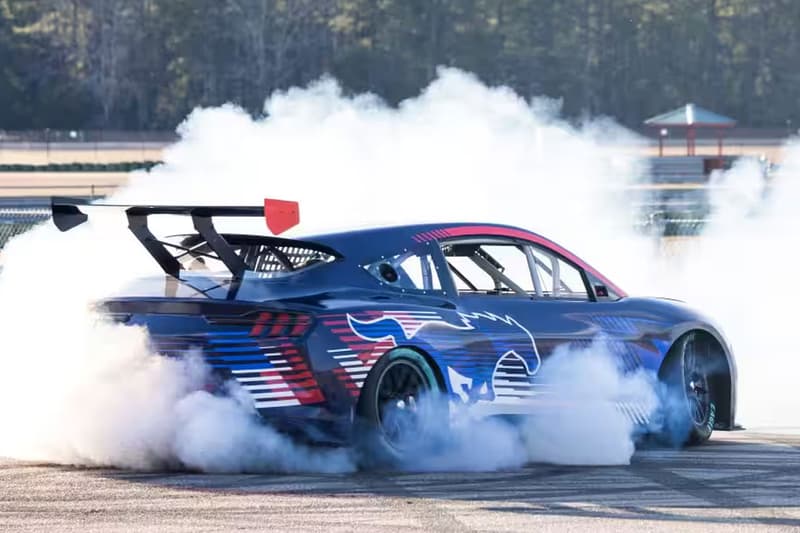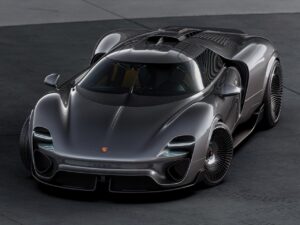
Ford is once again pushing the boundaries of electric vehicle (EV) performance, revealing a Mustang Mach-E-based NASCAR prototype that redefines the role of electric technology in motorsports. In a bold move signaling its commitment to electrification, Ford Performance has not only unveiled this groundbreaking race car but also announced that a high-performance Mach-E variant will compete in the 2025 Pikes Peak International Hill Climb.
The automaker’s latest innovations showcase a blend of performance, sustainability, and cutting-edge engineering, reinforcing the Mustang Mach-E as more than just an electric crossover—it’s now a legitimate racing machine. This article delves into Ford’s groundbreaking developments, exploring the impact of the NASCAR prototype and the upcoming Pikes Peak challenge.
Ford’s Electric NASCAR Prototype: A Game Changer for Stock Car Racing
For decades, NASCAR has been synonymous with roaring V8 engines and high-speed oval racing. However, as the automotive world shifts toward sustainability, even NASCAR is beginning to embrace electrification. Ford’s latest move—introducing an all-electric NASCAR prototype based on the Mustang Mach-E—marks a significant step in this transition.
While NASCAR has yet to adopt full EV racing officially, Ford’s prototype serves as a technological testbed, showcasing what an electric future for stock car racing could look like. This isn’t just a Mach-E with a roll cage—it’s a purpose-built racing machine designed to challenge conventional perceptions of electric vehicles.
Uncompromised Performance
Ford Performance has yet to disclose full specifications, but early reports suggest that this Mach-E NASCAR prototype will feature a high-powered, multi-motor electric drivetrain capable of producing well over 1,000 horsepower. Instant torque, a hallmark of EVs, will provide blistering acceleration, potentially surpassing traditional internal combustion NASCAR machines in short bursts of speed.
One of the major hurdles Ford aims to overcome is the balance between high performance and sustained endurance racing. Heat management is a significant challenge in EV motorsports, and Ford is reportedly integrating advanced cooling technologies to prevent thermal degradation during high-speed competition.
Aerodynamics and Design
Though based on the Mustang Mach-E, the NASCAR prototype is far from a road-going SUV. With an aggressive aerodynamic package, a lower stance, and extensive weight-saving modifications, this prototype is built for the track. It maintains a silhouette inspired by the Mach-E but incorporates elements designed for high-speed stability, including a large rear wing, widened fenders, and an enhanced chassis setup.
Inside, the vehicle is stripped down to the essentials—roll cages, racing seats, and a digital performance monitoring system replace traditional interior features. Every element is optimized for speed and safety, proving that Ford’s electric prototype is no gimmick—it’s a serious race car.
Why Pikes Peak?
The Pikes Peak International Hill Climb, also known as the “Race to the Clouds,” is one of the most challenging motorsport events in the world. Spanning 12.42 miles with 156 turns, the course climbs to an elevation of 14,115 feet, pushing both drivers and vehicles to their limits.
Electric vehicles have been making waves at Pikes Peak in recent years, with Volkswagen’s I.D. R setting the all-time record in 2018. Unlike traditional combustion engines, which suffer from oxygen depletion at higher altitudes, electric motors maintain full power regardless of elevation, making them well-suited for the grueling ascent.
Ford’s decision to enter a Mach-E-based contender in the 2025 Pikes Peak Hill Climb signals its ambition to dominate electric motorsport. This high-performance variant is expected to showcase advancements in battery cooling, aerodynamics, and high-output electric drivetrains.
While Ford has yet to reveal full details, expectations are high. The Mach-E racer will likely feature:
•Extreme Weight Reduction – To optimize speed and handling, the Pikes Peak Mach-E will undergo significant weight-saving measures, including carbon fiber bodywork and a stripped-down interior.
•Enhanced Aerodynamics – With high-speed cornering and elevation changes, aerodynamics will be key. Expect an aggressive front splitter, massive rear wing, and extensive airflow management to keep the vehicle planted.
•High-Power Electric Drivetrain – Likely equipped with multiple motors, the Mach-E Pikes Peak version could push beyond 1,000 horsepower, rivaling some of the most powerful EVs ever built.
•Advanced Battery Cooling – Heat management remains a challenge for high-performance EVs. Ford will likely incorporate cutting-edge cooling technologies to ensure consistent power delivery throughout the climb.
Ford’s entry into Pikes Peak isn’t just about competition—it’s a statement. By tackling one of the most demanding races in the world, the Blue Oval is proving that electric vehicles can deliver extreme performance in ways previously thought impossible.
Ford’s Electrification Strategy: Beyond Racing
Ford’s foray into electric motorsports isn’t happening in isolation. The company is aggressively expanding its EV lineup, investing billions into electric vehicle development and infrastructure. The Mustang Mach-E and F-150 Lightning have already positioned Ford as a leader in mainstream EV adoption, but performance remains a critical pillar of the brand’s identity.
By pushing the limits of electric performance through NASCAR and Pikes Peak, Ford is not only showcasing its technological capabilities but also influencing the future of EV development. Lessons learned from motorsports often trickle down to consumer vehicles, meaning that the advancements in battery efficiency, cooling systems, and power management developed for racing could benefit future road-going EVs.
Ford’s electrification strategy extends beyond just performance:
•Expanding Charging Infrastructure – Ford is investing in an extensive fast-charging network to support its growing EV lineup.
•Battery Innovations – The company is developing next-generation solid-state and high-energy-density batteries to improve range and charging times.
•Sustainable Manufacturing – Ford is committed to reducing its carbon footprint by using more sustainable materials and energy-efficient production processes.
By aligning its racing efforts with these broader initiatives, Ford is positioning itself at the forefront of the EV revolution.
The Future of Electric Racing: Ford Leading the Charge
With an electric NASCAR prototype and a Mach-E set to take on Pikes Peak, Ford is making it clear that high-performance electric racing is here to stay. These efforts not only reinforce the Mustang Mach-E’s credibility as a performance EV but also signal Ford’s commitment to shaping the future of motorsports.
As NASCAR considers electrification and events like Pikes Peak continue to attract EV innovators, Ford’s bold initiatives could be the catalyst for widespread change in racing. If successful, these efforts may pave the way for an all-electric NASCAR series and further push the boundaries of EV technology in competitive racing.
For now, all eyes are on Ford as it prepares for its upcoming challenges. Whether on the high-speed ovals of NASCAR or the treacherous ascent of Pikes Peak, the Mustang Mach-E is proving that the electric future isn’t just about efficiency—it’s about exhilarating performance, too.
No comments yet.







